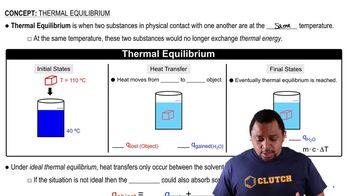(b) The specific heat of aluminum is 0.9 J/(g - K). Calculate its molar heat capacity.
Ch.5 - Thermochemistry
Chapter 5, Problem 50b
Two solid objects, A and B, are placed in boiling water and allowed to come to the temperature of the water. Each is then lifted out and placed in separate beakers containing 1000 g of water at 10.0 °C. Object A increases the water temperature by 3.50 °C; B increases the water temperature by 2.60 °C. (b) What can you say about the specific heats of A and B?
 Verified step by step guidance
Verified step by step guidance1
Understand the concept of specific heat capacity, which is the amount of heat required to change the temperature of a unit mass of a substance by one degree Celsius. It is denoted by the symbol \( c \) and is expressed in units of \( \text{J/g} \cdot \text{°C} \).
Recognize that when objects A and B are placed in water, they transfer heat to the water, causing the water's temperature to rise. The amount of heat transferred can be calculated using the formula \( q = m \cdot c \cdot \Delta T \), where \( q \) is the heat transferred, \( m \) is the mass of the water, \( c \) is the specific heat capacity of water, and \( \Delta T \) is the change in temperature.
Since both objects are initially at the same temperature (boiling water), the heat transferred from each object to the water is proportional to the temperature change of the water. Object A causes a larger temperature change (3.50 °C) compared to object B (2.60 °C), indicating that object A transfers more heat to the water.
Assuming both objects have the same mass and initial temperature, the difference in temperature change suggests that object A has a higher specific heat capacity than object B. This is because a higher specific heat capacity means the object can store more heat energy, which it then transfers to the water.
Conclude that the specific heat capacity of object A is greater than that of object B, as object A causes a larger increase in the water's temperature, indicating it has stored and transferred more heat energy.

Verified video answer for a similar problem:
This video solution was recommended by our tutors as helpful for the problem above.
Video duration:
3mWas this helpful?
Key Concepts
Here are the essential concepts you must grasp in order to answer the question correctly.
Specific Heat Capacity
Specific heat capacity is the amount of heat required to raise the temperature of one gram of a substance by one degree Celsius. It is a material property that varies between different substances, influencing how much energy they can absorb or release when their temperature changes.
Recommended video:
Guided course

Heat Capacity
Heat Transfer
Heat transfer refers to the movement of thermal energy from one object to another due to a temperature difference. In this scenario, when objects A and B are placed in water, they transfer heat to the water, causing a temperature change that can be measured to infer their specific heats.
Recommended video:
Guided course

Heat Capacity
Thermal Equilibrium
Thermal equilibrium occurs when two objects in contact reach the same temperature, resulting in no net heat transfer between them. In the context of the question, both objects A and B reach thermal equilibrium with the boiling water before being placed in the cooler water, allowing for a comparison of their specific heats based on the temperature changes observed.
Recommended video:
Guided course

Thermal Equilibrium
Related Practice
Textbook Question
Textbook Question
Two solid objects, A and B, are placed in boiling water and allowed to come to the temperature of the water. Each is then lifted out and placed in separate beakers containing 1000 g of water at 10.0 °C. Object A increases the water temperature by 3.50 °C; B increases the water temperature by 2.60 °C. (a) Which object has the larger heat capacity?
Textbook Question
(a) What amount of heat (in joules) is required to raise the temperature of 1 g of water by 1 kelvin? (b) What amount of heat (in joules) is required to raise the temperature of 1 mole of water by 1 kelvin?
Textbook Question
(c) What is the heat capacity of 185 g of liquid water?
1
views
Textbook Question
(d) How many kJ of heat are needed to raise the temperature of 5.00 kg of liquid water from 24.6 to 46.2 °C?
